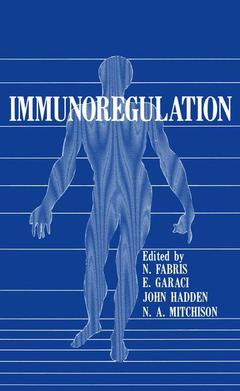Description
Immunoregulation, Softcover reprint of the original 1st ed. 1983
Coordinator: Fabris Nicola
Language: English
Subject for Immunoregulation:
Publication date: 03-2012
478 p. · 17.8x25.4 cm · Paperback
478 p. · 17.8x25.4 cm · Paperback
Description
/li>Contents
/li>
Immunoregulation is one of the areas which has witnessed the most explosive advances of immunology during the past decade. It is in this area that the current view of the immune system has arisen and developed. There is indeed little doubt that immune reactions are primarily determined by messages which are genera ted within the immune system and passed among different types of immunologie cells. This cell communication not only determines the type, intensity and duration of the response after perturbation of the immune system by exogenous antigens, but it is also essential for preventing autoimmune reactions and their clinical conse quences. In order to assure aperfect balance within the enormous com plexity of the immune system, it is not surprising that multiple self-regulatory mechanisms are organized at different levels, such as antibody feedback, idiotypic-anti-idiotypic responses, suppres sor and helper T cells, lymphokine signals and genetic require ments. A nu mb er of observations in recent years have, however, demonstrated that consistent contributions to the immunological homeostasis are given also by signals generated outside of the immune system, namely,in the central and autonomous nervous system as weIl as in the endocrine apparatus. Furthermore, the interactions between the immune system and the other body homestatic mechanisms seem to be bidirectional: if immunological cells may be targets of neuroendocrinological factors, immunological products seem in turn to contribute to the neuro endocrine homeostasis.
IgVH and MHC-Restricted Regulatory Circuit in the Immune Response.- Subpopulations of Human Lymphocytes and their Alterations in Immunodeficiency Diseases.- T-Cell Independent Activation of Human B Cells by Anti-Ig Antibodies and Protein A-Containing Staphylococci.- The Rise and Fall of the Antigen Bridge.- Primate Helper Factors: Comment on the ‘Antigen Bridge’.- Immunoregulation of “In Vitro” Antibody Response to Azobenzenearsonate (Aba)-Proteins.- Is the Immune System a Functional Idiotypic Network?.- Systemic Network Regulation Hypothesis: Some Experimental Evidence.- Antigen Specific Helper Factors: an Overview After Ten Years.- Fine Specificity of H-2-Restricted, Lysozyme Specific Suppressor T Cell Factor.- Marrow Regulating Factors (MRF) and Radiation Chimeras: a Model for Bone Marrow-Directed Immunity.- Role of Thymosin and the Neuroendocrine System in the Regulation of Immunity.- Thymic Factors in Experimental Diseases.- Lymphokines and the Lymphoendothelial System: an Illustration of Immunoregulatory Integration.- Cyclic Nucleotides and Related Mechanism in Immune Regulation: a Mini Review.- Anatomical and Physiological Connections Between the Central Nervous and the Immune Systems (Neuroimmunomodulation).- Immunoendocrinology: Endocrine Aspects of Autoimmune Disease.- Prostaglandins and Immunoregulation.- Behavioral Conditioning and Immunity.- Neuroendocrine Immunoregulation.- Thymus-Neuroendocrine Network.- Myasthenia Gravis: Thymic and Peripheral Blood Cell Interactions in Specific Antibody Production.- Muscular Dystrophies and Thymic Deficiency.- Ataxia-Telangiectasia: a Neuro-Endocrine-Immune Disease? Alternative Models of Pathogenesis.- Accelerated Aging in Down’s Syndrome: the Concept of Hierarchical Homeostasis in Relation to Local and Global Failure.- Natural Resistance Against Tumors In Vivo.- Immunogenetic Determinants Controlling the Metastatic Properties of Tumor Cells.- Contributors.
© 2024 LAVOISIER S.A.S.




